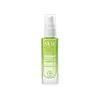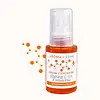What's inside
What's inside
 Key Ingredients
Key Ingredients

 Benefits
Benefits

 Concerns
Concerns

 Ingredients Side-by-side
Ingredients Side-by-side

Water
Skin ConditioningGluconolactone
Skin ConditioningMethyl Methacrylate Crosspolymer
Dicaprylyl Carbonate
EmollientNiacinamide
SmoothingPropanediol
SolventSodium Hydroxide
BufferingDimethicone
EmollientGlycerin
HumectantBiosaccharide Gum-4
Skin ConditioningCamellia Japonica Flower Extract
EmollientCetearyl Dimethicone Crosspolymer
Crithmum Maritimum Extract
Skin ConditioningPentaerythrityl Tetra-Di-T-Butyl Hydroxyhydrocinnamate
AntioxidantSclerotium Gum
Emulsion StabilisingSalicylic Acid
MaskingSodium Hyaluronate
HumectantTocopherol
Antioxidant1,2-Hexanediol
Skin ConditioningCaprylic/Capric Triglyceride
MaskingCetearyl Alcohol
EmollientGlyceryl Stearate
EmollientHydrogenated Vegetable Oil
EmollientPEG-100 Stearate
Coco-Glucoside
CleansingParfum
MaskingWater, Gluconolactone, Methyl Methacrylate Crosspolymer, Dicaprylyl Carbonate, Niacinamide, Propanediol, Sodium Hydroxide, Dimethicone, Glycerin, Biosaccharide Gum-4, Camellia Japonica Flower Extract, Cetearyl Dimethicone Crosspolymer, Crithmum Maritimum Extract, Pentaerythrityl Tetra-Di-T-Butyl Hydroxyhydrocinnamate, Sclerotium Gum, Salicylic Acid, Sodium Hyaluronate, Tocopherol, 1,2-Hexanediol, Caprylic/Capric Triglyceride, Cetearyl Alcohol, Glyceryl Stearate, Hydrogenated Vegetable Oil, PEG-100 Stearate, Coco-Glucoside, Parfum
Water
Skin ConditioningAscorbyl Glucoside 10%
AntioxidantGlycerin
HumectantSalix Nigra Bark Extract
Skin ProtectingSodium Hydroxide
BufferingSodium Levulinate
Skin ConditioningHaematococcus Pluvialis Extract
AntioxidantSodium Hyaluronate
HumectantSimmondsia Chinensis Seed Oil
EmollientAstragalus Gummifer Gum
Emulsion StabilisingLevulinic Acid
PerfumingSodium Anisate
AntimicrobialPhytic Acid
Polyepsilon-Lysine
Skin ConditioningTocopherol
AntioxidantHelianthus Annuus Seed Oil
EmollientWater, Ascorbyl Glucoside 10%, Glycerin, Salix Nigra Bark Extract, Sodium Hydroxide, Sodium Levulinate, Haematococcus Pluvialis Extract, Sodium Hyaluronate, Simmondsia Chinensis Seed Oil, Astragalus Gummifer Gum, Levulinic Acid, Sodium Anisate, Phytic Acid, Polyepsilon-Lysine, Tocopherol, Helianthus Annuus Seed Oil
 Reviews
Reviews

Ingredients Explained
These ingredients are found in both products.
Ingredients higher up in an ingredient list are typically present in a larger amount.
Glycerin is already naturally found in your skin. It helps moisturize and protect your skin.
A study from 2016 found glycerin to be more effective as a humectant than AHAs and hyaluronic acid.
As a humectant, it helps the skin stay hydrated by pulling moisture to your skin. The low molecular weight of glycerin allows it to pull moisture into the deeper layers of your skin.
Hydrated skin improves your skin barrier; Your skin barrier helps protect against irritants and bacteria.
Glycerin has also been found to have antimicrobial and antiviral properties. Due to these properties, glycerin is often used in wound and burn treatments.
In cosmetics, glycerin is usually derived from plants such as soybean or palm. However, it can also be sourced from animals, such as tallow or animal fat.
This ingredient is organic, colorless, odorless, and non-toxic.
Glycerin is the name for this ingredient in American English. British English uses Glycerol/Glycerine.
Learn more about GlycerinSodium Hyaluronate is hyaluronic acid's salt form. It is commonly derived from the sodium salt of hyaluronic acid.
Like hyaluronic acid, it is great at holding water and acts as a humectant. This makes it a great skin hydrating ingredient.
Sodium Hyaluronate is naturally occurring in our bodies and is mostly found in eye fluid and joints.
These are some other common types of Hyaluronic Acid:
Learn more about Sodium HyaluronateSodium Hydroxide is also known as lye or caustic soda. It is used to adjust the pH of products; many ingredients require a specific pH to be effective.
In small amounts, sodium hydroxide is considered safe to use. However, large amounts may cause chemical burns due to its high alkaline.
Your skin has a natural pH and acid mantle. This acid mantle helps prevent harmful bacteria from breaking through. The acid mantle also helps keep your skin hydrated.
"Alkaline" refers to a high pH level. A low pH level would be considered acidic.
Learn more about Sodium HydroxideTocopherol (also known as Vitamin E) is a common antioxidant used to help protect the skin from free-radicals and strengthen the skin barrier. It's also fat soluble - this means our skin is great at absorbing it.
Vitamin E also helps keep your natural skin lipids healthy. Your lipid skin barrier naturally consists of lipids, ceramides, and fatty acids. Vitamin E offers extra protection for your skin’s lipid barrier, keeping your skin healthy and nourished.
Another benefit is a bit of UV protection. Vitamin E helps reduce the damage caused by UVB rays. (It should not replace your sunscreen). Combining it with Vitamin C can decrease sunburned cells and hyperpigmentation after UV exposure.
You might have noticed Vitamin E + C often paired together. This is because it is great at stabilizing Vitamin C. Using the two together helps increase the effectiveness of both ingredients.
There are often claims that Vitamin E can reduce/prevent scarring, but these claims haven't been confirmed by scientific research.
Learn more about TocopherolWater. It's the most common cosmetic ingredient of all. You'll usually see it at the top of ingredient lists, meaning that it makes up the largest part of the product.
So why is it so popular? Water most often acts as a solvent - this means that it helps dissolve other ingredients into the formulation.
You'll also recognize water as that liquid we all need to stay alive. If you see this, drink a glass of water. Stay hydrated!
Learn more about Water